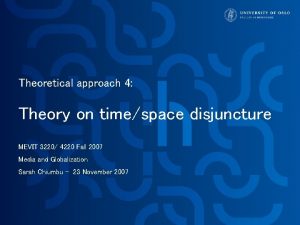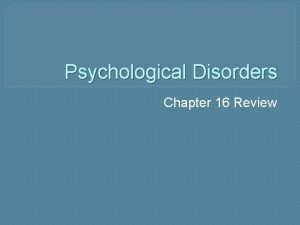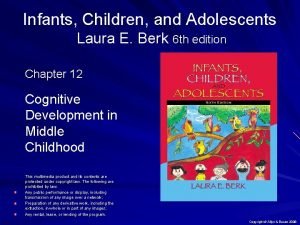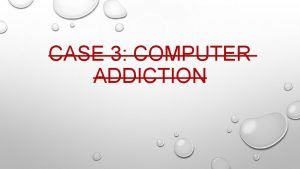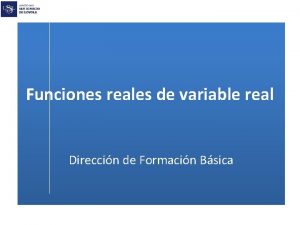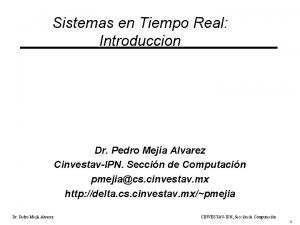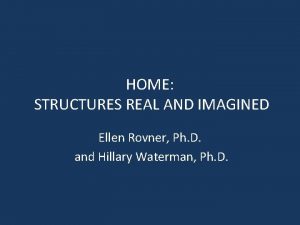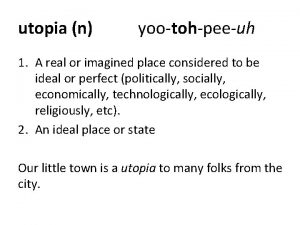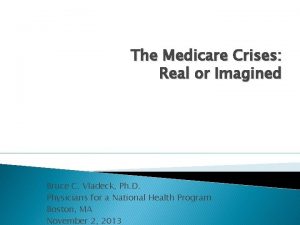Real or Imagined Community Support Do Adolescents in

















- Slides: 17

Real or Imagined Community Support: Do Adolescents in Recovery Know What Adults in Their Community Think and Feel About Them? Josephine D. Korchmarosa, Alison Greenea, & Bridget Murphyb a. University of Arizona-Southwest Institute for Research on Women (UA-SIROW) b. The Mobile Health for Youth and Families Institute Project funded by SAMHSA-CSAT (H 79 TI 20138) to UA-SIROW. Presentation funded by Women’s Studies Advisory Council (WOSAC) Travel Award to Josephine Korchmaros, J. D. (July, 2013). Real or Imagined Community Support: Do Adolescents in Recovery Know What Adults in Their Community Think and Feel About Them? Poster presented at The David A. Kenny Festschrift: Advances in Social Psychology, Storrs, CT.

ABSTRACT A substantial barrier to recovery from substance abuse is the stigma faced while in recovery. Knowledge of the accuracy of these perceptions can perhaps help prepare adolescents for recovery while immersed in the community. Adolescent girls in recovery from substance abuse and adult community members were surveyed about how the typical community member feels and thinks about adolescents in recovery. The girls’ and adults’ perceptions reflect public stigma regarding adolescents in recovery. Furthermore, all of the girls’ perceptions, except for their perception of the supportiveness of the community toward adolescents in recovery, were accurate. The girls’ perceived more public supportiveness than the adults did. These results suggest that girls in recovery have a realistic view of the stigma they do and will face within their community.

Stigma of Substance Abuse § Substance abusers in recovery face stigma - enacted, perceived, and self-stigma (Link et al. , 2004). § Public stigma = negative beliefs individuals in society have about individuals from stigmatized groups (Corrigan & Watson, 2002). § Perceived stigma = beliefs that members of a stigmatized group have about the prevalence of stigmatizing attitudes and actions in society (cf. , Link et al. , 1989). § Enacted stigma = directly experienced social discrimination such as poor support for treatment or interpersonal rejection.

The Influence of Perceived Public Stigma of Substance Abuse § How we feel about and view ourselves can be influenced by our perceptions of how others view us (Crocker & Major, 1989; Shrauger & Schoeneman, 1979). § Substance abusers tend to believe that most people with substance abuse problems are devalued or discriminated against (Luoma et al. , 2007). § Perceptions of public stigma (regardless of accuracy) negatively affect substance abuse recovery § Substance abusing individuals self-report fear of stigma as a reason for not seeking treatment § Substance abuse stigma disempowers addicted individuals (e. g. , Room, 2005; Tucker et al. , 1994). (Madden & Cavalieri, 2007).

The Influence of Perceived Public Stigma of Substance Abuse § Perceptions of public stigma (regardless of accuracy) negatively affect substance abuse recovery (continued) § Stigma about mental illness, such as substance abuse, can cause substance abusers to deny symptoms and delay treatment; and can interfere with recovery (Weiss, 2006). § Awareness of public stigma is associated with lower selfesteem, and greater anxiety and anger in patients (Norman et al. , 2011). § As perceived support decreased, women in recovery were twice as likely to report relapse (Van. De. Mark 2007). § Substance abusers report that receiving support from someone who believed in their ability to recover is essential for recovery (Van. De. Mark, 2007).

Importance of Examining the Accuracy of Perceived Public Stigma § Adds to the literature regarding accuracy of societal views generally and of substance abuse specifically. § Knowledge of the accuracy can inform substance abuse treatment programs. § If girls perceive more stigma than actually exists, efforts can be directed to correct these perceptions and, thus, prevent associated negative impacts on recovery. § Knowledge of the accuracy can help prepare girls for recovery while immersed in the community. § Prepare them for being exposed to public stigma that they might not realize exists. § Prepare them for the likelihood of enacted stigma.

Hypotheses § Girls’ and community members’ perceptions were expected to reflect known existing stigma regarding recovery from substance abuse. § We expected that girls’ perceptions of public stigma towards adolescents in recovery from substance abuse would be fairly accurate because (1) they are members of the same community and (2) there is a multitude of evidence in the community of the community’s view of people in recovery (e. g. , bus stop PA signs regarding meth use).

METHOD Participants 76 girls in recovery in residential substance abuse treatment § § Aged 13 – 17 (M = 15. 7) at intake into treatment 100% female 59% Hispanic 43% White, 8% multi-racial, 4% American Indian, 3% Black, and 4% other (38% reported being Hispanic with no designation of race) 33 community members § Aged 26 – 76 (M = 50. 7) § 73% female § 36% professional, 18% administrator, 12% consultant/self-employed, 9% artist/educator, 9% retail/salesperson, 6% healthcare worker, 6% public servant, 3% volunteer

Assessment § In your opinion, how sympathetic is the typical member of our community toward adolescents in recovery from alcohol and/or drug use? Very sympathetic-Moderately sympathetic-Somewhat sympathetic-Not at all sympathetic § In your opinion, how supportive is the typical member of our community of adolescents in recovery from alcohol and/or drug use? Very sympathetic-Moderately sympathetic-Somewhat sympathetic-Not at all sympathetic § In your opinion, how much does the typical member of our community feel like adolescents in recovery from alcohol and/or drug use will become productive members of the community? Very Much-Moderately-Somewhat-Not at all § In your opinion, how much does the typical member of our community feel like adolescents in recovery from alcohol and/or drug use will be successful in life? Very Much-Moderately-Somewhat-Not at all

Procedure Girls in recovery in residential substance abuse treatment 1. Youth, parents, and Health Educator meet during intake into residential treatment at the only local facility serving adolescents. They discuss the program and research, and complete the consent procedure. 2. Youth and Health Educator meet to complete baseline assessment. Adult community members 1. List of 129 community members created from multiple community contact lists (e. g. , contact list for community newsletter). 2. Email invitation to complete online survey about resources for adolescents in recovery from alcohol and/or drug use that are available in our community.

RESULTS Girls in recovery in residential substance abuse treatment 100% response rate Adult community members 26% response rate

Perceived sympathy of community toward adolescents in recovery: **No reliable difference between girls in recovery and adult community members (p=. 144) Perceived sympathy of community

Perceived supportiveness of community toward adolescents in recovery: **Reliable difference between girls in recovery and adult community members (p=. 007) Perceived supportiveness of community

Perceived potential of adolescents in recovery to become productive community members: **No reliable difference between girls in recovery and adult community members (p=. 445) Perceived potential productiveness

Perceived potential of adolescents in recovery to be successful in life: **No reliable difference between girls in recovery and adult community members (p=. 254) Perceived potential for success in life

CONCLUSION & IMPLICATIONS § The girls’ and adults’ perceptions reflect public stigma regarding adolescents in recovery. § Both groups perceived low community sympathy and supportiveness of adolescents in recovery. § Both groups perceived low potential for productiveness and for success in life for adolescents in recovery. § All of the girls’ perceptions, except for their perception of the supportiveness of the community toward adolescents in recovery, were accurate. § The girls’ perceived more public supportiveness than the adults did.

CONCLUSION & IMPLICATIONS § These results suggest that girls in recovery have a realistic view of the stigma they do and will face within their community. § Perhaps, then, continued efforts should be directed at decreasing the public stigma associated with recovery from substance abuse as opposed to trying to affect perceived stigma. § If adolescents’ perceptions of public stigma are accurate and responsive to changes in public stigma, a decrease in public stigma should lead to a corresponding change in perceptions of public stigma. § A decrease in public stigma might lead to increased social (affective and instrumental) support and, consequently, improved recovery from substance abuse problems (e. g. , Weisner et al. , 2003; Holtfreter et al. , 2004).
 Imagined community examples
Imagined community examples Benedict arnold imagined communities
Benedict arnold imagined communities Imagined communities summary
Imagined communities summary Heterostomia
Heterostomia Process of striving toward ideal functioning
Process of striving toward ideal functioning The adolescent in society guided reading
The adolescent in society guided reading Discontinuity of development
Discontinuity of development Lara berk
Lara berk Minor and major supporting details
Minor and major supporting details Community support options
Community support options Cisco support community
Cisco support community Cisco support forums
Cisco support forums Evaluate together in community mobilization
Evaluate together in community mobilization Advice from tablets for schools to avoid computer addiction
Advice from tablets for schools to avoid computer addiction Grafica vertical
Grafica vertical The real real fashion copywriter
The real real fashion copywriter Sensor and (tiempo real or real time)
Sensor and (tiempo real or real time) How can i use polynomials in real life
How can i use polynomials in real life
